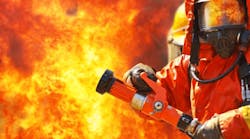The National Fire Protection Association estimates that 65,880 firefighter injuries occurred in the line of duty in 2013, a 5.1 percent drop from 2012 and the lowest total since the association began tracking firefighter injuries in 1981.
Based on survey data from fire departments, 45.2 percent of all injuries occurred during fire-ground operations, and the majority of those (55.3 percent) were strains and sprains, according to NFPA.
In the November/December edition of the NFPA Journal, the association notes that firefighter injuries have declined significantly since the 1980s and 1990s. However, part of this could be due to the fact that NFPA’s annual survey of fire departments now includes additional questions that separate exposures from injuries, the association says.
Among other highlights, NFPA estimates that:
- 29,760 firefighter injuries occurred during fire-ground operations; 11,800 occurred during other on-duty activities; 4,015 occurred while responding to or returning from an incident; 7,770 occurred during training; and 12,535 occurred at non-fire emergency incidents.
- There were 7,100 exposures to infectious diseases such as hepatitis, meningitis, and HIV in 2013. This amounts to 0.3 exposures per 1,000 emergency medical runs by fire departments last year.
- Some 10,000 injuries, or 15.2 percent of all firefighter injuries in 2013, resulted in time away from the job.
- There were 17,400 exposures to hazards such as asbestos, radioactive materials, chemicals and fumes in 2013, amounting to 16.7 exposures per 1,000 hazardous-condition runs.
- The Northeast reported a higher number of fire ground injuries per 100 fires than other regions of the country.
Injuries at the fire ground have plummeted from a high of 67,500 in 1981 to 29,760 in 2013, a decrease of 55.9 percent, according to NFPA. However, the association notes that the rate of injuries per 1,000 fires has not shown any consistent trend during the period.
The number of fires also has declined steadily since 1981, for an overall decrease of 57.1 percent.
“This suggests the fire-ground injury-rate risk has not changed much since 1981,” the association says.
Of the major types of injuries that occur during fire-ground operations, sprains and strains accounted for 55.3 percent in 2013; wounds, cuts, bleeding and bruising accounted for 13.8 percent; and burns accounted for 5.1 percent.
The leading causes of fire-ground injuries were overexertion and strain, which led to 26.5 percent of the injuries; and falls, jumps and slips, which led to 22.7 percent, according to NFPA.
